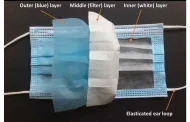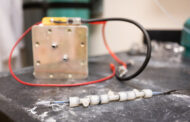
Printed mmWave array prototype for Gbit-data rate backscatter communication
Low-cost, Low-power Devices Work Over mmWave and Use a Single Transistor to Transfer High-volume Data Anywhere
The promise of 5G Internet of Things (IoT) networks requires more scalable and robust communication systems — ones that deliver drastically higher data rates and lower power consumption per device.
Backscatter radios ? passive sensors that reflect rather than radiate energy ? are known for their low-cost, low-complexity, and battery-free operation, making them a potential key enabler of this future although they typically feature low data rates and their performance strongly depends on the surrounding environment.
Researchers at the Georgia Institute of Technology, Nokia Bell Labs, and Heriot-Watt University have found a low-cost way for backscatter radios to support high-throughput communication and 5G-speed Gb/sec data transfer using only a single transistor when previously it required expensive and multiple stacked transistors.
Employing a unique modulation approach in the 5G 24/28 Gigahertz (GHz) bandwidth, the researchers have shown that these passive devices can transfer data safely and robustly from virtually any environment. The findings were reported earlier this month in the journal Nature Electronics.
Traditionally, mmWave communications, called the extremely high frequency band, is considered “the last mile” for broadband, with directive point-to-point and point-to-multipoint wireless links. This spectrum band offers many advantages, including wide available GHz bandwidth, which enables very large communication rates, and the ability to implement electrically large antenna arrays, enabling on-demand beamforming capabilities. However, such mmWave systems depend on high-cost components and systems.
The Struggle for Simplicity Versus Cost
“Typically, it was simplicity against cost. You could either do very simple things with one transistor or you need multiple transistors for more complex features, which made these systems very expensive,” said Emmanouil (Manos) Tentzeris, Ken Byers Professor in Flexible Electronics in Georgia Tech’s School of Electrical and Computer Engineering (ECE). “Now we’ve enhanced the complexity, making it very powerful but very low cost, so we’re getting the best of both worlds.”
“Our breakthrough is being able to communicate over 5G/millimeter-wave (mmWave) frequencies without actually having a full mmWave radio transmitter – only a single mmWave transistor is needed along much lower frequency electronics, such as the ones found in cell phones or WiFi devices. Lower operating frequency keeps the electronics’ power consumption and silicon cost low,” added first author Ioannis (John) Kimionis, a Georgia Tech Ph.D. graduate now a member of technical staff at Nokia Bell Labs. “Our work is scalable for any type of digital modulation and can be applied to any fixed or mobile device.”
The researchers are the first to use a backscatter radio for gigabit-data rate mmWave communications, while minimizing the front-end complexity to a single high-frequency transistor. Their breakthrough included the modulation as well as adding more intelligence to the signal that is driving the device.
“We kept the same RF front-end for scaling up the data rate without adding more transistors to our modulator, which makes it a scalable communicator,” Kimionis said, adding that their demonstration showed how a single mmWave transistor can support a wide range of modulation formats.
Powering a Host of ‘Smart’ IoT Sensors
The technology opens up a host of IoT 5G applications, including energy harvesting, which Georgia Tech researchers recently demonstrated using a specialized Rotman lens that collects 5G electromagnetic energy from all directions.
Tentzeris said additional applications for the backscatter technology could include “rugged” high-speed personal area networks with zero-power wearable/implantable sensors for monitoring oxygen or glucose levels in the blood or cardiac/EEG functions; smart home sensors that monitor temperature, chemicals, gases, and humidity; and smart agricultural applications for detecting frost on crops, analyzing soil nutrients, or even livestock tracking.
The researchers developed an early proof of concept of this backscatter modulation, which won third prize at the 2016 Nokia Bell Labs Prize. At the time, Kimionis was a Georgia Tech ECE doctoral researcher working with Tentzeris in the ATHENA lab, which advances novel technologies for electromagnetic, wireless, RF, millimeter-wave, and sub-terahertz applications.
Key Enabler of Low Cost: Additive Manufacturing
For Kimionis, the backscatter technology breakthrough reflects his goal to “democratize communications.” “Throughout my career I’ve looked for ways to make all types of communication more cost-efficient and more energy-efficient. Now, because the whole front end of our solution was created at such low complexity, it is compatible with printed electronics. We can literally print a mmWave antenna array that can support a low-power, low-complexity, and low-cost transmitter.”
Tentzeris considers affordable printing crucial to making their backscattering technology market viable. Georgia Tech is a pioneer in inkjet printing on virtually every material (paper, plastics, glass, flexible/organic substrates) and was one of the first research institutes to use 3D printing up to millimeter-frequency ranges back in 2002.
Original Article: Backscatter Breakthrough Runs Near-Zero-Power IoT Communicators at 5G Speeds Everywhere
More from: Georgia Institute of Technology | Bell Labs | Heriot-Watt University
The Latest Updates from Bing News & Google News
Go deeper with Bing News on:
Backscatter radios
- What’s that?…A fuel cell that harvests energy from…dirt?
A soil microbial fuel cell where microbes in dirt could power applications which are literally “in the field”.
- CUSTOMS TO PURCHASE 20 SNIFFER DOGS COSTING RM1.9 MLN
NILAI, April 26 (Bernama) -- The Royal Malaysian Customs Department (JKDM) is in the process of purchasing 20 sniffer dogs and three backscatter scanning machines to ensure more effective efforts in ...
- IAF’s Smart Fences Plan will greatly strengthen airfield security
Time is also ripe to raise special airfield defence units and train them to secure vulnerable installations and maybe gradually replace Defence Security Corps at airbases ...
Go deeper with Google Headlines on:
Backscatter radios
[google_news title=”” keyword=”backscatter radios” num_posts=”5″ blurb_length=”0″ show_thumb=”left”]
Go deeper with Bing News on:
5G Internet of Things networks
- What the heck happened to CDMA networks?
GSM and CDMA introduced digital transmission for both voice and data, and with it came enhanced privacy. Primarily through unique encoding for each call, and spreading phone calls across the entire ...
- Securing the edge: Cradlepoint’s strategy for robust 5G and edge computing integration
Cradlepoint's Camille Campbell discusses with theCUBE the company's NetCloud SASE offering and it's positioning in the 5G edge computing networking space.
- Cradlepoint unveils 5G SASE platform for mobile, distributed environments
NetCloud SASE integrates cellular SD-WAN and security capabilities into a cloud-based platform to secure and mitigate risk across managed and unmanaged devices.
- T-Mobile unveils new 5G internet plans for enhanced home and travel connectivity
T-Mobile has announced two new 5G Internet plans, “Home Internet Plus” and “Away.” Home Internet Plus targets a premium home internet experience with expanded Wi-Fi coverage and 24/7 tech support for ...
- What Is 5G Home Internet? Here’s Everything You Need to Know
Carriers are starting to offer home internet packages that rely on 5G cellular data service. We’ll help you decide if it’s right for you.
Go deeper with Google Headlines on:
5G Internet of Things networks
[google_news title=”” keyword=”5G Internet of Things networks” num_posts=”5″ blurb_length=”0″ show_thumb=”left”]







